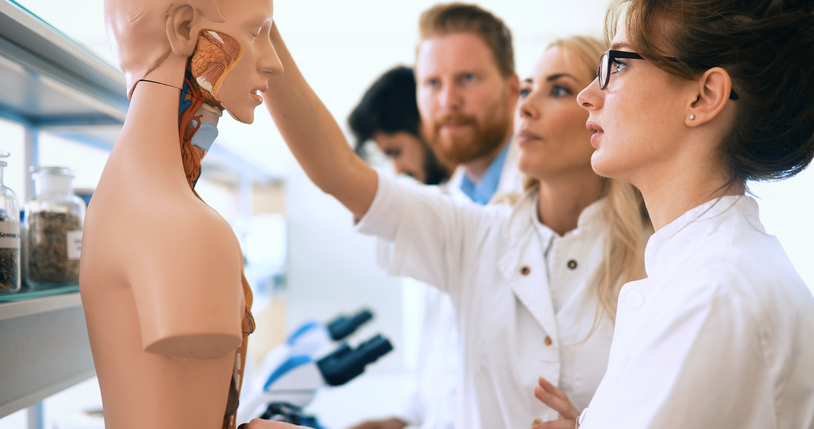Understanding how medical education in the U.S. works can be difficult. It is a lengthy process with multiple steps that appear similar but are very different. To make planning your medical education in the U.S. easier we curated an outline of each step and put them in chronological order.
For highlights on what to expect from pre-medical education through a medical fellowship, which will result in a sub-specialized medical license, continue reading below!
Pre-Medical Education (4 years)
Objectives:
-
-
- Earn a Bachelor’s Degree
- Maintain a Good GPA
- Take the MCAT
- Enhance Resume/CV
- Earn Letters of Evaluation
- Apply for Medical School
- Attend Medical School Interviews
-
Once an individual graduates from high school, the first step to becoming a physician is enrolling in undergraduate or pre-medical education. Individuals can earn a degree at a private or public university or college and can pursue any major or minor they would like. Most medical students are science-focused selecting a biological science, physical science, or math and statistics degree. Often, individuals choose such areas of study as the curriculum provides a primer for what they will learn in the future. These majors may also introduce individuals to material covered on the Medical College Admissions Test (MCAT).
More important than the degree a pre-medical student selects is their GPA. Because medical schools have limited seats, the application process is competitive. To have the best chance at securing a seat, individuals should prioritize their studies. Although medical schools require applicants to have a GPA of at least 3.0, most programs only accept applicants with GPAs of 3.5 or higher. The average GPA of medical students accepted into medical school in 2017 was just under 3.8.
Outside of formal education, pre-medical students must spend time preparing for and applying to medical school. Doing so will require them to take the MCAT and participate in experiences to enhance their curriculum vitae or resumes. Volunteering, assisting with research, working as a medical scribe, or participating in pre-med clinical experiences can all be valuable items to include. These types of activities show medical schools that an applicant is serious about the field and is willing to put in the work needed to have success. Such experience also provide talking points during school interviews. For more information on how a pre-med clinical experience can enhance your education, check out our post, 6 Benefits of Pre-Med Clinical Experiences.
In addition to crafting a standout resume, pre-medical students must earn letters of evaluation. These letters can be obtained during an individual’s pre-medical education or any one of the experiences listed above. Once an individual compiles their CV/resume, letters of evaluation, transcripts, and MCAT scores, they must submit these online. These items are to be uploaded to the American Medical College Application Service. Additional information on applying through medical school through this platform can be found on the American Association of Medical College’s (AAMC) site, here.
Medical School (4 Years)
Objectives:
-
-
- Take USMLE Steps 1 and 2
- Select a Medical Specialty
- Craft a Personal Statement
- Update CV/Resume
- Earn Letters of Recommendation
- Register with the NRMP
- Attend Residency Program Interviews
- Rank Residency Programs by Preference
-
Medical school lasts four years and, upon completion, graduates will earn an M.D. degree. The first two years of school focus on textbook and classroom learning. The final two years take students outside of the classroom and into the hospital and private practice settings with clinical experience.
Upon completion of the first two years of medical school, students should be ready to take the USMLE Step 1. This first step in the U.S. Medical Licensing Exam tests for an understanding of basic science and medical ethics.
The second two years of medical school will have a greater focus on patient care, with hours spent outside of the classroom in the hospital and clinic settings. The curriculum covered will follow specific medical specialties and should prepare students to take the USMLE Step 2 clinical skills and clinical knowledge. Both the USMLE Steps 1 and 2, CS and CK, are required to apply for medical residency. During a student’s fourth year, they may begin to consider which medical specialty they are most interested in and start applying for residencies in this area.
Medical resident hopefuls will need to go through the National Resident Matching Program (NRMP). The NRMP holds an annual match that connects medical graduates with residency programs based on both parties’ preferences for one another. The process of applying to The Match is not unlike applying to medical school. It requires individuals to upload their transcripts, test scores, CV/resume, personal statement, and letters of recommendation (LoRs) through an online portal. In this case, this portal is called Electronic Residency Application Service (ERAS). Those who do not have LoRs at this point may elect to participate in additional clinical experiences to earn these important documents.
Need another LoR? AMO Can help! Explore 200+ online and in-person experiences >
After uploading required documents to ERAS, medical students will need to tour and have interviews with the residency programs they are most interested in. Following interviews, individuals will be able to rank programs based on their preferences. On Match Day, medical students will be notified if they have been accepted into a program of their choice. In the event they have not, they may be eligible to match into a program with open seats or, they may have to wait until next year to apply again.
Residency (3+ Years)
Objectives:
-
-
- Take USMLE Step 3
- Apply for a Fellowship (Optional)
- Obtain a Medical License
-
Depending on the specialty selected, medical residencies can last 3-7 years. Those who participate in medical residencies may be called residents or resident physicians. During residency, medical graduates are paid an annual salary. Daily tasks of medical residents include shadowing and assisting physicians as they care for patients. Depending on the leeway given, medical residents may provide medical attention themselves and participate in procedures, including surgeries. In most cases, residents will have a restricted medical license to be used for training purposes.
There are also educational aspects to medical residencies that require residents to participate in research projects and conferences with frequency. When these requirements are combined with patient consultation, hospital rounds, and other healthcare duties, a medical resident’s day can become quite long. Recently, the Accreditation Council for Graduate Medical Education (ACGME) chose to limit the number of hours residents could work in a set period of time. Now residents must not work more than 24 hours in a single shift, and their weekly hours should not extend past 80 hours.
Although medical residency can be long and stressful, it is well worth the work. Upon completion of the USMLE Step 3 and medical residency, individuals are eligible to apply for an unrestricted medical license. The process of licensing may vary by state and specialty. Additional information on the process can be found here.
Fellowship (1+ Years, Optional)
For those looking to specialize beyond what is possible during a medical residency, a supplemental medical fellowship can provide additional education. Medical fellowship programs are generally small and, as a result, competitive. Those interested in pursuing a sub-specialization through a fellowship explore options in their last years of medical residency. This will allow them to be prepared to apply for programs when the time comes.
Fellowships are comparable to residency programs in relation to the application process, the stipend, and the actual experience. The caveat is that fellowship programs are often shorter, with most lasting 1-2 years. Applications, like those completed for residency, require individuals to submit documents online through ERAS. This is followed by interviews and a matching process.
When accepted into a fellowship, individuals are given a stipend and begin their training, which can result in a sub-specialty license should they choose to apply for one upon program completion.
Excited to start your medical education? Let us help!
A pre-med clinical experience can put you on the right path.







Leave A Comment